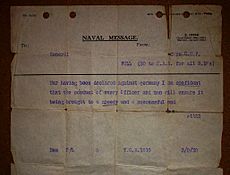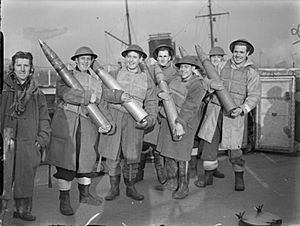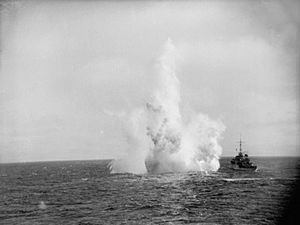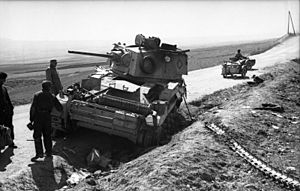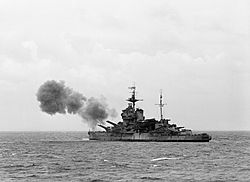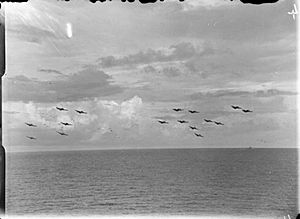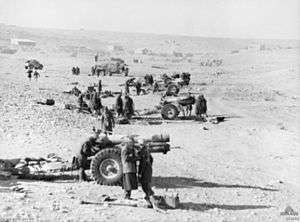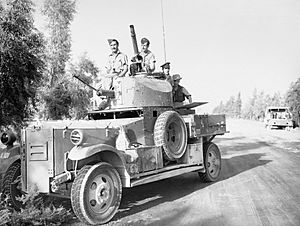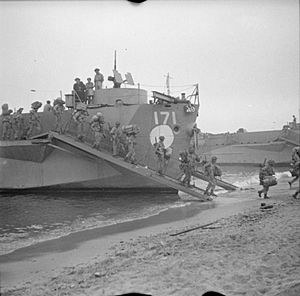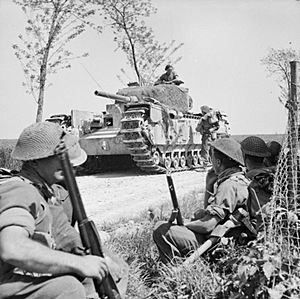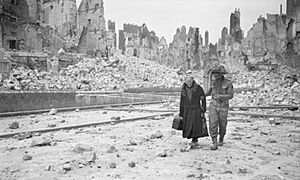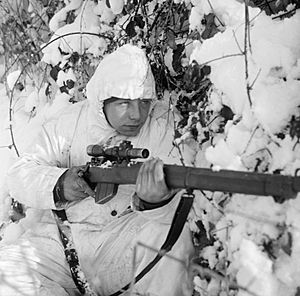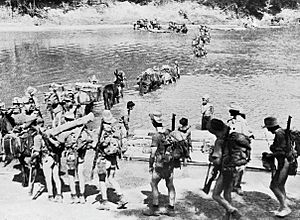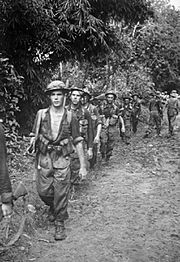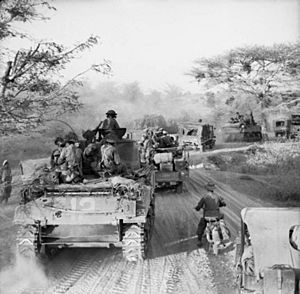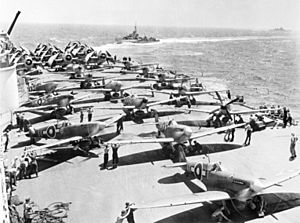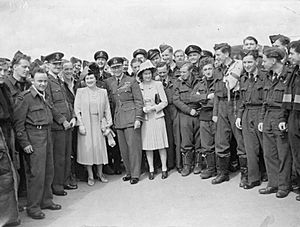Military history of the United Kingdom during World War II facts for kids
| 1939–1945 | |
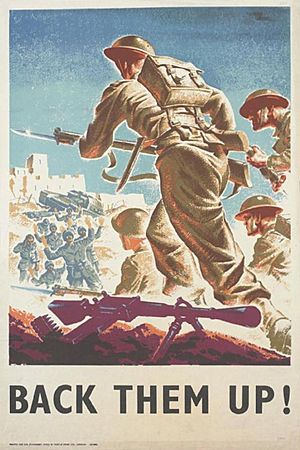
A British poster from World War II
|
|
| Preceded by | Interwar Britain |
|---|---|
| Followed by | Postwar Britain |
| Monarch | George VI |
| Leader(s) | |
The United Kingdom in World War II tells the story of how Britain and its Empire fought in the Second World War. This huge conflict began for the UK on 3 September 1939. That's when Britain and France declared war on Nazi Germany. They did this after Germany invaded Poland.
At first, there wasn't much the British and French could do to help Poland. This early period was called the Phoney War. It ended in April 1940 when Germany invaded Denmark and Norway. Soon after, in May 1940, Winston Churchill became Prime Minister.
Germany then quickly defeated other European countries. These included Belgium, the Netherlands, Luxembourg, and France. British soldiers, part of the British Expeditionary Force, had to escape from Dunkirk in June 1940.
Britain and its Empire kept fighting Germany alone. Churchill got industries, scientists, and engineers to help the war effort. Germany planned to invade Britain, but the Royal Air Force (RAF) stopped them. The RAF won the Battle of Britain by defeating the German air force, the Luftwaffe. This meant Germany couldn't control the skies. After this, British cities faced heavy bombing during the Blitz in 1940 and 1941.
The Royal Navy worked to block Germany's supplies by sea. They also protected merchant ships in the long Battle of the Atlantic. The British Army fought back in the Mediterranean and Middle East. This included campaigns in North Africa, East Africa, and the Balkans.
In June 1941, Britain and its allies signed the Declaration of St James's Palace. They promised not to make a separate peace with Germany. Churchill also made an alliance with the Soviet Union in July. He started sending them supplies. By August, Churchill and US President Franklin D. Roosevelt created the Atlantic Charter. This set out goals for the world after the war.
In December 1941, Japan attacked British and American areas. This included an attack on the US fleet at Pearl Harbor. Britain and America then declared war on Japan. This started the Pacific War. The Grand Alliance was formed between the UK, the US, and the Soviet Union. They agreed to focus on defeating Germany first. The Declaration by United Nations in December 1941 officially formed the Allies of World War II.
The Allies faced many defeats in Asia and the Pacific in early 1942. The Eastern Front between the Soviet Union and Germany became the biggest war zone ever.
Victories came in 1943 in North Africa, led by General Bernard Montgomery. Then came the Italian campaign. British forces helped a lot with secret Ultra intelligence. They also took part in bombing Germany and the Normandy landings in June 1944. Europe was freed on 8 May 1945. This was thanks to the Soviet Union, the United States, the UK, and other Allied countries. The Battle of the Atlantic was the longest fight of the war.
The Pacific War was mainly fought by China, the US, and Japan. It was the largest area of the war. In Southeast Asia, the British Eastern Fleet attacked in the Indian Ocean. The British Army led the Burma campaign to push Japan out of the British colony. This campaign involved a million troops, mostly from British India. It succeeded in mid-1945. The British Pacific Fleet fought in the Battle of Okinawa. They also took part in the final attacks on Japan. British scientists helped with the Manhattan Project to build the atomic bomb. The decision to use these bombs led to Japan's surrender on 15 August 1945. The war officially ended on 2 September 1945.
For more about life in Britain during the war, see United Kingdom home front during World War II.
Contents
Preparing for War
Even though Britain spent more money on its military before 1939, its forces were still weak. This was especially true for the British Army. Only the Royal Navy was stronger than Germany's navy. The British Army had only nine divisions ready for war. Germany had seventy-eight, and France had eighty-six.
Still, Britain was a rich country with a strong military. It had a global network from its Empire. After becoming Prime Minister in 1940, Winston Churchill brought in scientists and engineers. They helped the government and military with the war effort. Many important inventions, like radar, were developed before 1940. These were shared with the Americans. This led to a lot of teamwork in technology between the Allies.
War Begins
As Germany prepared to attack, the Polish Navy sent three destroyers to Britain in August 1939. These ships, Burza, Błyskawica, and Grom, fought alongside the Royal Navy for the rest of the war.
On 3 September, Britain and France declared war on Germany. This was because Germany had invaded Poland. The Royal Navy also gained two Polish submarines, Orzeł and Wilk.
The British Army quickly sent the British Expeditionary Force (BEF) to France. At first, it was made up of regular soldiers. Later, men from the Territorial Army joined. The BEF grew to 200,000 men. The Royal Air Force (RAF) also sent planes to France. Some helped the French Army with scouting. Others were Hawker Hurricane fighter planes.
During the "Phoney War," the RAF did small bombing raids. They also dropped many propaganda leaflets. The Royal Navy blocked Germany's coast.
Fighting in Western and Northern Europe, 1940-1941
Norwegian Campaign

Norway was important to Germany because of its iron ore and long coastline. Germany invaded Norway on 9 April 1940. Britain quickly sent troops to Norway. They landed in central and northern areas.
British forces landed at Namsos in April 1940. They tried to stop the Germans from moving north. But German air attacks and supply problems made it hard. All British troops were evacuated by 4 May 1940.
In central Norway, the Royal Navy and RAF couldn't hold their bases. They had to leave. In the north, Germans were pushed out of Narvik. But again, air attacks made it impossible to keep bases. British forces in Narvik also left.
Because Norway and Denmark were lost, the Royal Navy occupied the Faroe Islands and Iceland. This was to set up naval and air bases.
Battle for France
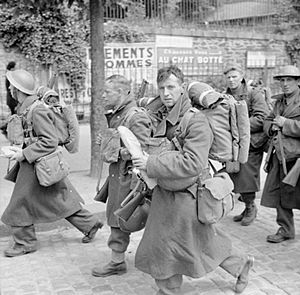
After Germany invaded Poland, the British Expeditionary Force (BEF) went to the French-Belgian border. By March 1940, the BEF had 316,000 men.
The "Phoney War" ended on 10 May 1940. Germany launched a huge invasion of Belgium, the Netherlands, and Luxembourg. German troops entered France through the Ardennes forest. Most Allied forces were in Belgium. They expected a repeat of World War I tactics.
The German army quickly moved towards the coast. This trapped the BEF from three sides. British forces tried to stop them, including a counter-attack at Arras. But the BEF couldn't stop the Germans. The Channel ports were in danger. Fresh troops were sent from England to defend Boulogne and Calais. But both ports fell by 26 May.
The BEF was ordered to withdraw to Dunkirk. This was the only port left for evacuation. In total, 338,226 troops were rescued from the beaches. Most of them were British. However, almost all the army's equipment was left behind in France.
Some British forces were cut off from Dunkirk. These included the 51st (Highland) Infantry Division and the 1st Armoured Division. Churchill wanted to form a "Second BEF" to defend France. But General Alan Brooke convinced him that the remaining forces would be destroyed. Churchill ordered all British troops to leave France. From 15 to 25 June, 191,870 Allied troops were rescued from other French ports. The troopship Lancastria was bombed, killing about 4,000 people.
France surrendered after six weeks. Britain and its Empire were left to fight alone. The British worried that Germany might use French warships. So, they took control of French ships in British ports. They also attacked the French fleet at Mers-el-Kebir in North Africa. This was to stop the ships from falling into enemy hands.
During the Battle of France, Neville Chamberlain resigned as Prime Minister. Winston Churchill took his place. Churchill had always opposed making peace with Hitler.
War at Sea
The Royal Navy was much stronger than the German Kriegsmarine. Its main jobs were to:
- Keep the North Atlantic open for shipping.
- Keep the Mediterranean open for the Allies and closed to Germany and Italy.
- Keep routes open through the Indian Ocean to India and Australia.
The Japanese Navy was very powerful. In the Pacific, it mainly fought the United States Navy. It also hit the Royal Navy hard in 1941-42 near Singapore and Ceylon.
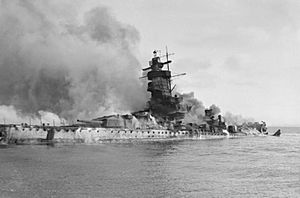
At the start of the war, Britain and France expected to control the seas. They believed their navies were superior. They immediately began a blockade of Germany. This didn't affect German industry much. The German navy started attacking British ships. They used both surface ships and U-boats. The German cruiser Admiral Graf Spee was cornered in the Battle of the River Plate. Its captain sank the ship.
Battle of the Atlantic
This was a long fight between merchant ships (often in convoys) and German submarines. The battle went back and forth. But in 1943, the Allies gained a big advantage. They used destroyers, air patrols, new depth charges, and secret Ultra intelligence. This intelligence helped them find German submarine groups called "wolfpacks."
First "Happy Time"
After France fell in June 1940, ports like Brest became large submarine bases. This led to a huge increase in British ship sinkings. German U-boat commanders called this period the "First Happy Time."
By 1941, the United States and Canada were helping more. British forces had occupied Iceland. The US sent forces to relieve British troops there. American warships started escorting convoys to Iceland. They had some clashes with U-boats. The US Navy also helped escort the main Atlantic convoys.
America also provided fifty old destroyers to the Royal Navy in 1940. This was in exchange for leases on British bases. These ships helped with anti-submarine patrols.
Second "Happy Time"
When Japan entered the war in December 1941, it became a global conflict. German U-boats launched a very successful campaign along the American east coast. Many ships sunk were on their way to join convoys to the UK. German sailors called this the "second happy time." It ended when a convoy system was set up along the coast.
Winning Against U-boats
A new convoy system along the American coast and in the Caribbean in mid-1942 greatly reduced attacks. Attention shifted back to the Atlantic convoys.
In May 1943, things changed suddenly. Two convoys were attacked by large wolfpacks. They suffered losses, but the attacking submarines also took heavy hits. After these battles, merchant ship losses dropped sharply. U-boat losses soared. This forced German Admiral Karl Dönitz to pull his forces from the Atlantic. They never posed the same threat again.
This change happened because several new technologies came together. Long-range B-24 Liberator aircraft could now cover the middle of the Atlantic. New radar systems greatly improved detection. The Leigh Light allowed accurate attacks on U-boats at night. Convoys were better protected. This freed up resources for escort carrier groups to hunt U-boats aggressively.
Arctic Convoys
The Arctic convoys sailed from the US and UK to northern Soviet Union ports. 85 Allied merchant ships and 16 Royal Navy warships were lost. Germany lost one battlecruiser, at least 30 U-boats, and many aircraft. These convoys provided important supplies to the Soviet Union.
The Mediterranean Sea

The Royal Navy fought the Italian Navy for three years to control the Mediterranean. Germany also sent U-boats to the area.
At the start of the war, British and French navies were strong. Italy was neutral. But when France fell and Italy declared war, things changed. The British Mediterranean Fleet was based in Alexandria. A new force, Force H, was formed at Gibraltar. Britain worried that remaining French ships might be used by the Axis. So, they took steps to stop this.
At Alexandria, French ships were held in port. In the western Mediterranean, the main French fleet was at Mers-el-Kebir. Force H attacked them, causing heavy damage. The French government broke ties with Britain.
Battle of Taranto
The Italian fleet was strong in the central Mediterranean. The Royal Navy planned to cripple it. On 11 November 1940, the Royal Navy used planes from an aircraft carrier. These planes, old Fairey Swordfish, damaged or destroyed three Italian battleships in port at Taranto. The Italian fleet moved away from Taranto. Japan used lessons from this battle to plan their attack on Pearl Harbor.
Battle of Matapan
The first big fleet battle in the Mediterranean was the Battle of Cape Matapan. It was a major Allied victory in March 1941. British and Australian forces, led by Admiral Andrew Cunningham, intercepted the Italian navy. The Allies sank three Italian heavy cruisers and two destroyers. They also damaged a battleship. The British lost one torpedo plane.
Yugoslavia, Greece, and Crete
Germany invaded Yugoslavia on 6 April 1941. They won quickly. The Battle of Greece followed. British Commonwealth forces joined Greek forces against German, Italian, and Bulgarian troops. More than 62,000 Commonwealth troops landed in Greece.
After the German invasion, only Crete remained in Allied hands. Germans invaded Crete. They forced British forces to evacuate. Fewer than 20,000 of over 40,000 Allied soldiers escaped. The Royal Navy lost 4 cruisers and 6 destroyers during the evacuation.
Malta
Malta was a key island in the middle of the Mediterranean. It was perfect for stopping Axis supplies to North Africa. For a while, it looked like German and Italian aircraft would starve Malta into surrender. The turning point came in August 1942. Britain sent a heavily defended convoy called Operation Pedestal. Even though about half the ships were sunk, the convoy delivered enough food and fuel. This allowed Malta to hold out. With the help of Ultra intelligence, Malta-based planes and submarines sank vital Axis ships. This happened just before the Second Battle of El Alamein. Malta was awarded the George Cross for its bravery.
Large Invasions
In late 1942, Operation Torch was launched. This was the first large Allied combined operation. British and American forces landed in French North Africa. This led to Germany invading Tunisia.
Torch was followed by Operation Husky, the invasion of Sicily. Then came Operation Avalanche, the invasion of southern Italy. Naval forces escorted the invasion fleets. After Avalanche, Italy surrendered. British naval forces escorted the Italian fleet to Malta. The main threat to Allied shipping in Italy was German guided weapons.
After the Italian fleet surrendered, naval operations in the Mediterranean became simpler. They mostly involved supporting ground troops, anti-submarine missions, and convoy escort.
Normandy Landings
The Normandy Landings were the biggest amphibious assault ever. Over 1,000 warships and 5,000 other ships were involved. Almost all major UK ports were full before the attack.
Five assault divisions crossed the channel. There were two task forces: the Anglo-Canadian Eastern Task Force and the American Western Task Force. The Royal Navy provided most of the naval power. Coastal Command secured the invasion route from German submarines. Surface ships protected the convoys. Hundreds of minesweepers cleared paths. Eight battleships took part in the bombardment. The strong German defenses of the Atlantic Wall were hard to fight.
The assault went well. British losses were small. Few ships were sunk by German naval forces. U-boats and mines caused problems, but they were dealt with.
War in the East
Indian Ocean Disaster
The Indian Ocean was not a main battle area. But British convoys there were vital for supplying Allied forces in North Africa. They faced threats from German and Japanese ships and submarines.
In December 1941, British forces in Singapore were reinforced. This included the battleship HMS Prince of Wales and battlecruiser HMS Repulse. But on 10 December, Japanese aircraft sank both ships. This was a huge blow. It was the first time battleships were sunk by airpower while fighting at sea.
Japanese forces captured Malaya, Singapore, and the Dutch East Indies. Remaining British warships withdrew to Ceylon. In February 1942, they formed the British Eastern Fleet. This fleet looked strong on paper. But many of its battleships were old.
In April 1942, the main Japanese carrier force entered the Indian Ocean. They attacked the British fleet. Two British heavy cruisers, an aircraft carrier, and an Australian destroyer were sunk. Luckily, the main British fleet avoided contact with the Japanese.
Indian Ocean Retreat
After these attacks, the British fleet moved to Kilindini in East Africa. Their forward bases couldn't be protected from Japanese attacks. The fleet in the Indian Ocean was then reduced. More powerful ships were sent to other areas.
One exception was Operation Ironclad. This was a campaign to capture Madagascar. It was feared that Vichy French Madagascar might fall to Japan. This would have hurt British supply lines. The French resisted, but the island eventually fell.
Indian Ocean Strike
Large British forces returned to the Indian Ocean in late 1944. This was after the German fleet was neutralized. The success of Operation Overlord meant more ships could be sent.
In late 1944, British aircraft carriers attacked oil targets in Sumatra. This prepared them for operations in the Pacific. The oil facilities were heavily damaged. This made Japan's fuel shortages worse.
After the main battle forces left, the Indian Ocean fleet had escort carriers and older battleships. They supported the recapture of Burma. This included landings on Ramree, Akyab, and near Rangoon.
Blockade of Japan
British forces played a smaller but important role in cutting off Japan's trade. Early successes came from laying mines. Japanese minesweeping was weak. British submarines also attacked Japanese shipping. They sank several Japanese cruisers.
North Africa, Middle East, and Africa
On 13 September 1940, the Italian Tenth Army invaded Egypt from Libya. British troops were protecting the Suez Canal. The Italians reached Sidi Barrani. At this time, only 30,000 British troops faced 250,000 Italian troops. The Italians stopped their advance. This was partly because they didn't know how strong the British were. Also, British naval forces disrupted Italian supply lines.
The Offensive
On 11 November 1940, the Royal Navy crippled three Italian battleships at Taranto.
Then, on 8 December 1940, Operation Compass began. British, Indian, and Australian troops cut off the Italian forces. General Richard O'Connor pushed the attack forward. They reached El Agheila, capturing thousands of enemy troops. The Italian army was almost destroyed. It looked like the Italians would be swept out of Libya. But Churchill ordered the advance to stop. Troops were sent to defend Greece instead. Weeks later, German troops arrived in North Africa to help the Italians.
Iraq, Syria, and Persia
In May 1941, there was a coup in Iraq against the pro-British government. A pro-German ruler took power. He ordered British forces out. There were two main British bases in Iraq: Basra and Habbaniya. Habbaniya was a poorly defended air base. But RAF personnel used training aircraft to bomb Iraqi forces. British columns then captured Baghdad.
During this campaign, a German plane was shot down over Iraq. It had flown through Vichy-controlled Syria. This was a hostile act. So, after victory in Iraq, British forces invaded Syria and Lebanon. They removed the Vichy officials. The French resisted strongly, but eventually surrendered.
The last major military operation in the Middle East happened soon after. The Soviet Union desperately needed supplies for its war against Germany. Supplies were sent via the Arctic. But more capacity was needed. The obvious route was through Persia (now Iran). The Shah of Persia was pro-German. So, British and Soviet forces invaded and occupied Persia. The Shah was removed, and his son took the throne.
Ethiopia Campaign
When Italy declared war in June 1940, a front opened in East Africa. This was in and around Italian colonies: Ethiopia, Italian Somaliland, and Eritrea.
British forces were greatly outnumbered. But Ethiopia was cut off from Italy. The Italians couldn't get supplies.
The Italians attacked first. They moved into Sudan, Kenya, and British Somaliland. They only fully succeeded in British Somaliland. The British garrison there was outnumbered and evacuated to Aden. In Sudan and Kenya, the Italians only captured small border areas.
After their attacks slowed, the Italians waited for the British counter-attack. Then, attention shifted to the sea. The Italians had a small naval squadron in Eritrea. This threatened British convoys in the Red Sea. But the squadron was not used aggressively. As fuel ran low, its chances for action decreased. Most of its surface ships were sunk. Submarines that escaped sailed around the Cape of Good Hope back to Italy.
British forces were few in East Africa. South Africa and India made the biggest contributions. South Africa provided airpower and troops. The British Indian Army formed the main ground forces. Two Indian divisions fought in Ethiopia.
Irregular forces also played an important role. Major Orde Wingate helped the Ethiopian "patriots." These irregulars disrupted Italian supply lines and provided intelligence.
The main push to take Ethiopia began when reinforcements arrived from Egypt. The Indian 4th and 5th Infantry Divisions attacked from Sudan. Another thrust came from Kenya. An amphibious assault on British Somaliland was launched from Aden. These three attacks met at the Ethiopian capital, Addis Ababa, which fell in May 1941.
The Italians made a final stand at Amba Alagi. They were defeated in mid-May 1941. The last major Italian forces surrendered at Gondar in November 1941.
War in the Western Desert
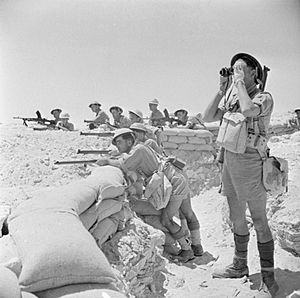
After Rommel's first attack, British command was reorganized. In November 1941, the British Eighth Army was formed. Its first attack failed. General Erwin Rommel stopped it. British tank tactics were not good for desert warfare. The commander, General Alan Cunningham, was replaced by Major General Neil Ritchie. However, a second British attack in late 1941 pushed Rommel back. They relieved Tobruk and advanced to El Agheila. But then, events in the Far East meant reinforcements for the Middle East were sent elsewhere.
Rommel attacked again in January 1942. He was told to make only a small attack. But he ignored orders and exploited the British collapse. He pushed deep into Egypt. Tobruk fell quickly. A defensive line at Mersa Matruh was outflanked. Disaster seemed near. Ritchie was dismissed. General Claude Auchinleck took command of the Eighth Army. He managed to stop Rommel at El Alamein.
A new command team arrived. General Bernard Montgomery took command of the Eighth Army. Rommel tried to break through again at the Battle of Alam Halfa, but he was stopped. Montgomery then prepared a big attack to push Axis forces all the way to Tunisia.
Operation Torch and El Alamein
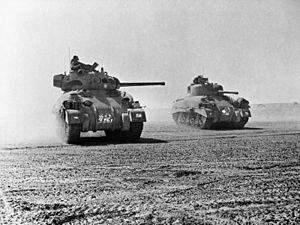
On 8 November 1942, Operation Torch began. This was the first large amphibious assault of World War II. An Anglo-American force landed in Algeria and Morocco. The Allies pretended it was an American operation to reduce French resistance.
After the attack on the French fleet at Mers el Kebir in 1940, many French people disliked the British. It was feared a British attack on French soil would lead to long resistance. The attack with the most resistance was the American landing in Morocco. A full naval battle was fought.
The resistance didn't last long. The French surrendered and joined the Allies. This was partly because Germany had moved into unoccupied France.
Once resistance ended, the campaign became a race. Germany was sending many men and supplies to Tunisia. The Allies tried to get enough troops there quickly to stop them.
Just before Operation Torch, the Second Battle of El Alamein was fought in Egypt. General Montgomery had a chance to defeat Rommel's Panzerarmee Afrika. Rommel's supply lines were stretched. The British were close to their bases. And Rommel was about to be attacked from behind by Torch.
The Second Battle of El Alamein used a lot of artillery. Rommel's forces had laid many mines. The terrain made it hard to go around his position. So, the German lines had to be attacked directly. Montgomery used tricks like "dummy tanks" to fool the Germans.
The main attack began. But it was stopped by the minefields. Montgomery then shifted the attack to another point. Through a tough battle, the Germans were pushed back.
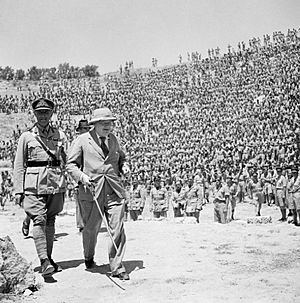
After El Alamein, Rommel's forces were chased across the desert. Cyrenaica and Tripolitania were retaken. Rommel's forces did not fight again until they reached the Mareth Line defenses in southern Tunisia.
Battle for Tunisia
As British forces moved west and Anglo-American forces moved east, the Axis sent reinforcements to Tunisia. A new German command was set up.
Rommel faced Montgomery's forces at the Mareth Line. This was a series of old French border defenses. Rommel improved them greatly. It took a big effort for British forces to break through. By this time, Rommel had left Africa for good.
It was decided that the First Army would make the main push to destroy Axis forces in Africa. The Eighth Army would make a smaller push along the coast.
The final offensive began in late March 1943. By May, Axis forces had surrendered. 250,000 men were taken prisoner.
Italian Campaign
The Italian Campaign was the name for Allied operations in and around Italy. It lasted from 1943 until the end of the war.
Invasion of Sicily
On 10 July 1943, Sicily was invaded. This operation, called Operation Husky, was led from Malta. British forces attacked on the eastern side. Their job was to advance up the east coast. When their advance slowed, the American Seventh Army swept around the enemy flank. Local Sicilians supported the Americans.
The Eighth Army eventually fought past German defenses. By 17 August, all Axis forces had left the island. Messina was captured that day.
Italy Surrenders
After Sicily, the Italian government was close to collapse. Italian dictator Benito Mussolini was removed from power. Peace talks began with the Allies. But the invasion of Italy still went ahead.
On 3 September 1943, the Eighth Army attacked across the Straits of Messina. Montgomery's forces moved up the toe of Italy. A smaller landing, Operation Slapstick, was also made at the Italian naval base of Taranto.
Also on 3 September, King Victor Emmanuel and Marshal Pietro Badoglio secretly signed an armistice with the Allies. On 8 September, the armistice was announced. A new Italian government joined the Allies.
The main attack, Operation Avalanche, happened on 9 September at Salerno. Salerno was chosen because fighter planes from Sicily could provide air cover there. The Germans reacted very quickly to the Italian surrender. They disarmed Italian troops and took up defensive positions.
The landings at Salerno were made by the US Fifth Army. It included the British X Corps. Initial resistance was heavy. But strong naval and air support, plus the Eighth Army's approach, forced the Germans to withdraw. By 25 September, Allied forces controlled a line from Naples to Bari.
Advances continued for a few weeks. But by late October, the front stalled. The Germans had taken up strong defensive positions on the Winter Line. The front stayed there for six months.
Mussolini was rescued by the Germans. He set up the Italian Social Republic in northern Italy.
Winter Line, Anzio, and Monte Cassino
The key to the Winter Line was the town and monastery of Monte Cassino. This strong position controlled a main route to Rome. British forces tried to cross the Garigliano River but were pushed back.
To get around the Winter Line, an amphibious landing was planned behind it. Operation Shingle involved landings at Anzio on 23 January 1944. The British 1st Infantry Division and 2nd Commando Brigade were part of this attack.
Like Salerno, there were problems. The commander didn't push forward aggressively enough. The Germans almost broke through the beachhead. But massive Allied firepower saved it.
After the initial attack and German counter-attack, the Anzio beachhead became a stalemate. The attempt to outflank the Winter Line had failed. It was May before a breakout could be tried.
Breakthrough to Rome
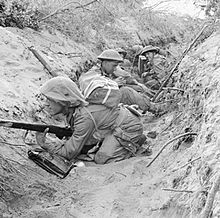
By May 1944, the US VI Corps had seven divisions. In the Fourth Battle of Monte Cassino, a big attack was made at both Anzio and the Winter Line. The German defenses finally broke.
The front was reorganized. The Eighth Army moved to focus more forces on taking Rome. Several battles for Cassino followed. Indian, New Zealand, and Polish forces fought there. Cassino lost its key position as other operations turned its flanks.
Rome fell on 5 June. The pursuit continued into northern Italy.
Gothic Line and Victory in Italy
By late August 1944, Allied forces reached Pisa and Pesaro. The advance then slowed. The Eighth Army slowly moved up the east coast. The Polish II Corps captured the port of Ancona. This shortened Allied supply lines.
Operations stopped for the winter. The offensive began again in April 1945. The Eighth Army made the main attack.
By 20 April, Bologna was held by the Germans. Lake Comacchio was crossed by an amphibious attack. The Germans were close to breaking. In the next ten days, German forces were surrounded or pushed against the River Po.
On 28 April, Mussolini was captured and executed by Italian partisans.
On 29 April, Marshal Rodolfo Graziani surrendered Mussolini's army.
Progress in May was fast. American forces cleared the upper Po Valley. Polish forces captured Bologna. British forces cleared the lower Po and reached the Yugoslav and Austrian borders.
On 2 May, German forces in Italy surrendered. This was shortly before the main German surrender on 8 May.
Liberating Europe
Operation Overlord
The Normandy Landings happened on 6 June 1944. All ground armies, US and British, were under British General Montgomery. Five divisions landed from the sea. Three divisions landed by parachute and glider. One airborne and two seaborne divisions were British. The British 6th Airborne Division landed to secure the eastern flank. The first Allied units were glider troops attacking Pegasus Bridge.
The UK was the main base for the operation. It provided most of the naval power. Nearly eighty percent of the warships were from the Royal Navy. Airpower was more evenly split. The RAF's Coastal Command secured the English Channel. Bomber Command attacked German transport targets in France. Air Defence of the United Kingdom provided air superiority. The 2nd Tactical Air Force supported the British forces.
The operation was a success. Both tactical and strategic surprise were achieved. Most initial goals for the day were not met. But a strong beachhead was established. It was built up until attacks could begin. The first major success was capturing Cherbourg.
In the east, the main British goal was Caen. This was a very tough fight. The battle for the city was long. It finally fell in July.
Breaking Out of Normandy

British and Canadian forces largely destroyed German tanks in eastern Normandy. This allowed American forces to break out in late July 1944 in Operation Cobra. Allied forces began to surround the remaining German forces in Normandy. Hitler ordered a counter-attack.
As American forces swept south, British, Canadian, and Polish forces pushed the Germans from the north. A German pocket formed south of Falaise. Up to 150,000 German soldiers were trapped. About 60,000 were killed or wounded.
General Dwight D. Eisenhower took over as Ground Forces Commander from Montgomery on 1 September. Montgomery continued to command the British 21st Army Group.
After Normandy, there was little German resistance left in the west. British forces swept north into Belgium in September 1944. American forces swept east. Paris fell in late August 1944. By the end of September, much of France was free.
Then, supply problems caught up with the Allies. All supplies had to come from Normandy. The American fast advance slowed down. Heated discussions took place about the next strategy.
Operation Market Garden
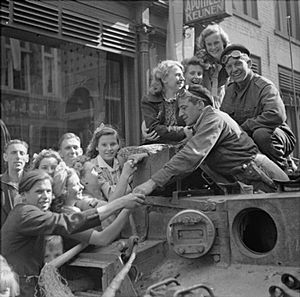
Montgomery and Eisenhower debated how to attack Germany. Montgomery wanted to focus power in one area. Eisenhower preferred a broad attack. But in late 1944, supply problems made a broad attack impossible. Montgomery planned Operation Market Garden. The idea was to land airborne forces in the Netherlands to capture vital bridges. Armored forces would then relieve them and advance into Germany.
American paratroopers landed at points north of Allied lines. The British 1st Airborne Division and Polish 1st Independent Parachute Brigade landed at Arnhem. All bridges were captured on the first day except the Nijmegen bridge. This caused a two-day delay. The plan then ran into serious trouble. The relief forces had to advance on a single road. The Germans quickly attacked the road from both sides. It took much longer than expected to reach Arnhem. By the time they arrived, the British 1st Airborne had surrendered at the bridge.
The 1st Airborne Division held the Arnhem bridge for four days. A large force stayed over the river for nine days. They finally withdrew in a daring night escape. Of over 10,000 men, only about 2,000 returned. The 1st Airborne Division was no longer a fighting force.
Walcheren Island
After Market Garden, the port of Antwerp was captured. But it was at the end of a long river estuary. It couldn't be used until its approaches were clear. The southern bank of the Scheldt was cleared quickly. But the island of Walcheren remained.
Walcheren guarded the northern approaches to Antwerp. So, it had to be stormed. The dikes and dunes were bombed to flood the island. In the last big amphibious operation in Europe, British Commandos and Canadian troops captured the island in late 1944. This cleared the way for Antwerp to open. It helped ease the Allies' critical supply problems.
Battle of the Bulge
After December 1944, the plan was to conquer the Rhineland and invade Germany. But the Germans launched their last big attack in December. This led to the Battle of the Bulge. They tried to repeat their 1940 success by attacking through the Ardennes. They found weak forces there.
Most forces in the Battle of the Bulge were American. The US Third and Ninth Armies turned to contain the German attack. The German attack cut off the First and Ninth Armies from their headquarters. So, they were put under the command of the British 21st Army Group. The British XXX Corps also helped stop further German advances.
By late January, the German attack was pushed back. The mission to free the Rhineland restarted.
Crossing the Rhine and Final Surrender
The British XIII Corps cleared German forces from the west bank of the Roer River in January 1945.
Then, the British Second and US Ninth Armies led the crossing of the Rhine. The Ninth Army helped surround German forces in the Ruhr. The US First Army crossed the Rhine in early April. They then moved to free the northern Netherlands. The Second Army drove across the North German plain. They reached the Ems on 1 April and the Weser on 4 April.
On 15 April, British troops liberated Bergen-Belsen concentration camp.
By 18 April, British troops reached the coast in much of the Netherlands. This isolated German forces there. The Second Army reached the Elbe the next day. British units reached the Baltic on 2 May. They stopped there, as they had met Soviet forces. The war ended on 7 May. British forces then began occupying Germany.
War in the Far East
The South-East Asian Theatre included campaigns in Hong Kong, India, Burma, Thailand, Indochina, Malaya, and Singapore. On 7-8 December 1941, Japan invaded Hong Kong, Thailand, and Malaya. Britain declared war on Japan the same day. The fighting ended when Japan announced its surrender on 15 August 1945. The formal surrender was on 2 September 1945.
Disaster in Malaya and Singapore
When war broke out in the Far East, Britain was stretched thin. British forces there were weak. On 8 December 1941, Japan invaded Thailand, Malaya, and Hong Kong.
On 10 December 1941, the battleship HMS Prince of Wales and battlecruiser HMS Repulse were sunk by Japanese planes. This was a major setback. It was the first time a battleship was sunk by enemy aircraft while moving at sea.
Japanese forces had naval superiority. They used it to make landings as they advanced down the Malayan peninsula towards Singapore. The RAF tried to defend Singapore. But there were never enough planes to stop the Japanese. Indian, British, and Australian army forces in Malaya were larger. But they were not well prepared. They were steadily pushed back.
In early 1942, Singapore was not ready for the attack. It had been neglected. The governor refused to allow defensive preparations before the Japanese arrived.
After Japanese landings on Singapore, intense fighting happened. But the Allied forces were driven into a small area.
On 15 February 1942, General Arthur Percival surrendered the 80,000-strong garrison of Singapore. This was the largest surrender of British-led personnel in history. Many troops saw little fighting. The people of Singapore then suffered under brutal Japanese occupation.
Burma Campaign
The Burma Campaign involved forces from the British Commonwealth, China, and the United States. They fought against Japan, Thailand, and the Indian National Army.
Commonwealth ground forces came from the UK, British India, East Africa, West Africa, and Nepal. Air and naval units were mainly from the UK, India, Australia, New Zealand, South Africa, and Canada.
Forced Out of Burma
In Burma, the Japanese attacked in January 1942. They made real progress after Malaya and Singapore fell. Tokyo sent many aircraft to Burma.
The first Japanese attacks aimed to take Rangoon, Burma's main port. It was defended by weak RAF forces and American Volunteer Group planes. But as the Japanese attack grew, Rangoon airfields became unusable.
By early March, Japanese forces cut the British forces in two. Rangoon was evacuated. Its garrison broke through Japanese lines. The British commander in Burma, General Thomas Hutton, was replaced by General Harold Alexander.
With Rangoon's fall, a British evacuation of Burma was certain. Supplies couldn't be moved on a large scale. Ground communications were bad. Sea communications were risky. Air communications were impossible due to lack of transport planes.
The British forces retreated almost constantly. They suffered losses. But they reached India in May 1942, just before the monsoon.
Forgotten Army
Operations in Burma in 1942 and 1943 were frustrating. Britain could only manage three active campaigns. Attacks in both the Middle East and Far East were impossible due to lack of resources. The Middle East was chosen as it was closer and against the more dangerous Germans.
During the 1942-1943 dry season, two operations were launched. The first was a small attack into the Arakan region. It largely failed due to supply and communication problems. The second was the 77th Indian Infantry Brigade, known as the Chindits.
Under Major General Orde Wingate, the Chindits went deep behind enemy lines in 1944. They aimed to gather intelligence and disrupt communications. The operation was originally part of a larger offensive that was cancelled. But it went ahead anyway.
About 3,000 men entered Burma. They damaged Japanese communications and gathered intelligence. But they suffered terrible casualties. Only two-thirds returned. They were often sick and in bad physical shape. The Chindits showed that supplies could be dropped by air over the jungle. Some believe the Japanese decided to attack in Burma because of the Chindit operation. This decision proved fatal for the Japanese.
Kohima and Imphal
As the 1943-44 dry season began, both sides prepared to attack. The British Fourteenth Army struck first.
In Arakan, a British advance began. But a Japanese counter-attack stopped it. Unlike before, British forces held their ground. They were supplied by air. The Battle of Ngakyedauk Pass was a heavy defeat for the Japanese. With air supply, their tactics of carrying their own supplies were ruined.
On the central front, IV Corps advanced into Burma. But signs of a major Japanese offensive made them retreat to Kohima and Imphal. Forward elements were almost cut off. But they made it back to India. The British forces prepared for a long siege.
The Japanese attacked the defenses of Kohima and Imphal repeatedly. But they couldn't break through. Supplies were sometimes low, but never critical. It became a battle of who could last longer. The British could. The Japanese ran out of supplies and suffered huge losses. They broke and fled back into Burma.
Burma Retaken
Burma was recaptured in late 1944 and early 1945. Command of British forces was reorganized in November 1944.
Some of the first operations to retake Burma were in Arakan. To get bases for aircraft, two islands, Akyab and Ramree, had to be captured. Akyab was undefended. Ramree was defended by thousands of Japanese. Clearing the island took days. After these actions, XV Corps was reduced to free up transport aircraft for the Fourteenth Army.
The Fourteenth Army made the main push to destroy Japanese forces in Burma. The plan was for XXXIII Corps to take Mandalay and distract the Japanese. IV Corps would take Meiktila to cut Japanese communications. The plan worked very well. Japanese forces in Upper Burma were scattered. Slim's men then advanced south towards the Burmese capital.
After Rangoon was taken in May 1945, some Japanese forces remained in Burma. But it was mostly a cleanup operation.
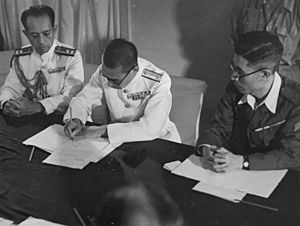
Malaya
The next major campaign was to free Malaya. This involved an amphibious assault called Operation Zipper. The atomic bombs in August 1945 stopped Zipper. But some landings happened after Japan surrendered. This was the quickest way to get occupation troops into Malaya. Under Operation Jurist, Penang was retaken on 2 September 1945. The Japanese garrison in Singapore formally surrendered on 12 September under Operation Tiderace. The rest of Malaya was freed in the following weeks.
Okinawa and Japan
In their final actions, British naval forces fought in the Battle of Okinawa. They also took part in the final naval attacks on Japan. The British Pacific Fleet operated separately from American forces at Okinawa. Its job was to attack airfields between Formosa and Okinawa. This prevented Japan from sending reinforcements. British forces helped a lot in the invasion's success.
During the final attacks on Japan, British forces worked as part of the American task force.
Only a small British naval force was present for Japan's surrender. Most British forces were preparing for Operation Downfall, the huge invasion of Japan.
War in the Air
Battle of Britain: 1940
The "Battle of Britain" in autumn 1940 involved German plans to invade Britain. First, the Luftwaffe tried to destroy the Royal Air Force (RAF). They attacked RAF airfields and radar stations. But when RAF bombers attacked Berlin, Hitler ordered attacks on London. This was a big mistake. The Luftwaffe wasted resources attacking civilians instead of airfields. London was not a factory city. British aircraft production actually increased. The last German daylight raid was on 30 September. The Luftwaffe realized its losses were too high. Occasional night raids still hit cities. About 43,000 civilians were killed. The Luftwaffe lost 1733 planes, while the British lost 915. The British won due to better focus, radar, and ground control.
Strategic Bombing
The British had their own plan for strategic bombing. They built long-range bombers. Before 1944, German industrial targets were too far away. So, RAF bombers focused on military and transport targets in France and Belgium. The Allies gained air control in Europe in 1944. This meant Allied supplies and reinforcements could reach the front. But enemy supplies could not. The Allies could concentrate their air power wherever they wanted. This was a key Allied strategy, and it worked. Air superiority depended on having fast, agile fighters. The RAF showed this in the Battle of Britain. Their fast Spitfire and Hawker Hurricane fighters easily shot down clumsy German planes. Building the fastest fighter became a main goal of World War II.
RAF Expansion
The RAF grew quickly after war started in 1939. This was helped by the Ottawa Agreement that year. The UK, Canada, Australia, and New Zealand agreed to train aircrews together. A total of 167,000 personnel were trained, mostly in Canada. Many RAF squadrons also included aircrews from other Commonwealth countries.
Another 43 squadrons were formed during the war. These were made up of aircrews from occupied European countries. They included Polish, French, Norwegian, and other units. Two "Eagle Squadrons" were formed by American volunteers before the US entered the war.
Combined Bomber Offensive
The combined bomber offensive was needed to strike Germany. This was during the years when Britain had no forces on mainland Europe. At first, bomber forces were small. Rules for attacks were strict. But after France fell in 1940, things changed.
During and after the Battle of Britain, bombers attacked invasion fleets. They also raided Berlin after German bombs hit London. Hitler was so angry that he ordered attacks on British cities in revenge. Throughout 1941, Bomber Command raids grew. But German defenses meant raids were mostly at night. Navigation technology wasn't accurate enough to hit targets precisely.
America joining the war in December 1941 didn't change much at first. But Air Chief Marshal Sir Arthur Harris became head of Bomber Command in early 1942. Harris strongly believed in bombing German cities. He brought new energy to Bomber Command. In summer 1942, the first 1,000-bomber raids were launched.
Other important technical advances happened. The first navigation aid, GEE, was introduced. Window, small metal strips, confused German radars. Planes also got their own radar, the H2S radar system. This gave a radar map of the ground. But the most important improvement was tactical. It was the pathfinder system. Pathfinders were trained crews who flew ahead of the main raid. They marked the target. This greatly improved accuracy.
By early 1943, American forces were building up in the UK. The Eighth Air Force joined Bomber Command. Bomber Command flew at night, and the Eighth flew by day. Raids were often coordinated. Hamburg was hit by one of the most destructive air raids in history in 1943. The city was easy to find by radar. It was devastated by a firestorm. About 50,000 people were killed.
The destruction of Hamburg was not repeated in 1943 and 1944. Berlin was attacked many times that winter. Bomber Command suffered heavy losses. The Fifteenth Air Force also started flying from Italy. In early 1944, the role of bomber forces changed. As the invasion of France neared, they were put under General Eisenhower. Harris and his American counterparts fought against this, but they lost.
Bomber Command heavily bombed targets in France. This helped paralyze the transport system for Operation Overlord in June 1944. After Overlord, they supported troops directly. But Harris eventually got his command back from Eisenhower. Bombing of German cities resumed.
By winter 1944, British and American bomber forces were huge. 1,000-bomber raids were common. Accuracy had improved. But it was still not "precision bombing." Precision meant a district, not a single building. The RAF and American AAF dropped two million tons of bombs on 60 German cities. More than half a million people were killed. 80,000 airmen died.
As Germany lost territory, Bomber Command's task became easier. German night fighter defenses also weakened. This was because American bombing cut Germany's fuel supplies. There was one last big controversy. It would damage Bomber Command's reputation.
In February 1945, Soviet forces neared Dresden. The city had been mostly spared heavy bombing. Soviets asked for attacks on its transport links. Bomber Command and American forces carried out very heavy raids. About 25,000 people were killed. Questions were asked if these raids were necessary so late in the war.
Bomber Command played no further large part in the war. Many RAF bombers were preparing for deployment to Okinawa when Japan surrendered. So, only American bombers and British and American carrier aircraft attacked Japan. There was no combined bomber offensive in the Far East.
|


